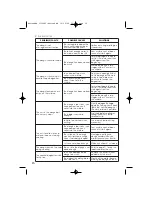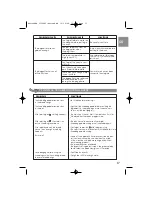
1
ST STAGE: KNEADING AND RISING OF THE
DOUGH
• Plug in the bread machine
- fig. 3
.
• After the sound signal, programme 1 is
displayed by default
- fig. 9
.
• Press the
“menu”
button and select
programme .
• Select the crust colour out of the 3 options
available
- fig. 12
:
-
Light for sweet baguettes, bun type
baguettes and brioche type baguettes.
Light setting cooks at a lower temperature.
- Medium or Dark for standard baguettes with
selected crust colour. If you are making 2
baguettes rather than 4, they will bake faster.
• Press button
- fig. 10
. The operating
light comes on and the 2 timer dots start
blinking
- fig. 13
. The dough kneading
cycle starts up, followed by the rising cycle.
N
OTE:
- The 2 stages (kneading and rising of the
dough) take place automatically and
last a total of 1 hour and 21 minutes (26
minutes of kneading followed by a
further 55 minutes rising for the dough)
- During the kneading stage, it is normal for
the dough not to be evenly blended.
-
Once the preparation is finished, the
machine goes into standby. Several sound
signals will tell you that the kneading and
rising of the dough is finished and the
operating indicator light will blink
- fig. 13
.
After the sound signals, the dough must
be shaped and baked within one hour.
After that time, the machine resets itself
and the baguette programme is lost.
2
ND STAGE: SHAPING AND BAKING THE BAGUETTES
To help you through those steps, refer to the
bagu ette shaping guide supplied. This shows
you how a professional baker would shape
the baguettes. With practise you will gain
the skill to do this yourself. if you find this
detailed shaping too complex, just knead a
quarter of the dough into a sausage shape
about 16 to 18 cm long. The baguettes will
still look and taste as good.
• Remove the pan from the machine
- fig. 15
.
• Sprinkle a little flour on your work surface.
• Remove the dough from the pan and put
it on your work surface.
• Roll the dough into a ball and, using a
sharp knife, divide it into 4 equal-sized
pieces
- fig. 18
.
• Each of the 4 pieces should be about the
same weight to ensure the cooked
baguettes are the same size.
TIP
To make your baguettes lighter and more
airy, leave the dough balls to rest for five
minutes before shaping them.
Follow the steps below for each piece of dough.
1) Flatten the dough into a rectangular
shape, approximately 1 cm thick.
2) Fold in half along its length.
3) Starting at one edge of the rectangle, join
the dough together by pressing it with the
palm of your hand throughout the length
of the rectangle. You will thus get a thinner,
more even rectangle.
4) Turn the rectangle over again, positioning
the join on top.
5) Fold it in half again, rolling the dough
around your thumb and pressing the join
with the palm of your hand, so that the
dough remains taught to seal the dough
and lengthen the dough.
6) Repeat steps 4 and 5 until you get the
desired length. The thickness and width of
the dough must remain even.
The length of the baguette must be the
same as that of the non-stick baking tray
(approximately 18 cm).
7) Roll the dough with your hands without
pressing it too much until you get a regular
shape.
TIP
You can vary the appearance of your
baguettes by adding your own extra touches.
For this, during stage 7 above, simply lightly
brush with cold water and then roll them in
sesame or poppy seeds or other grains.
• Once you have shaped the baguettes, lay
them in the non-stick trays
- fig. 19
.
The join in the dough must be underneath.
• For best results, make diagonal cuts, about
1 cm deep, on the top of the baguettes
with a serrated knife or with the razor cutter
- fig. 20+21
.
GB
11
NoticeHBB_3316683:NoticeHBB 19/12/08 12:05 Page 11




















